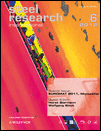
STEEL RESEARCH INTERNATIONAL
Scope & Guideline
Elevating Research Standards in Steel Studies.
Introduction
Aims and Scopes
- Metallurgical Processes and Innovations:
Research on innovative methods and technologies in steel production, including casting, welding, and processing techniques that enhance efficiency and quality. - Material Properties and Performance:
Studies focused on the mechanical, chemical, and physical properties of various steel grades and their behavior under different environmental conditions and treatments. - Environmental Impact and Sustainability:
Investigations into reducing the carbon footprint of steel production processes, improving recycling methods, and developing sustainable practices in metallurgy. - Advanced Characterization Techniques:
Application of advanced materials characterization methods to understand microstructure-property relationships in steel and other alloy systems. - Computational Modeling and Simulation:
Use of numerical simulations and modeling techniques to predict behavior and optimize processes in steel manufacturing and treatment.
Trending and Emerging
- Machine Learning and Artificial Intelligence Applications:
An increasing number of studies are integrating machine learning and AI techniques to optimize steel production processes and predict material properties. - High-Entropy Alloys and Advanced Materials:
Research on high-entropy alloys and complex alloy systems is gaining momentum, exploring their unique properties and potential applications in various industries. - Sustainable Steel Production Practices:
There is a growing focus on sustainability, with research aimed at reducing emissions, recycling materials, and improving the environmental impact of steel production. - Additive Manufacturing and 3D Printing in Steel:
The exploration of additive manufacturing techniques for steel components is becoming more prevalent, highlighting innovations in design and production methods. - Corrosion Resistance and Protective Coatings:
An emerging area of research is the development of advanced coatings and treatments to enhance the corrosion resistance of steel, especially in harsh environments.
Declining or Waning
- Traditional Steelmaking Processes:
Research focused on conventional steelmaking methods, such as basic oxygen furnace (BOF) and electric arc furnace (EAF), has seen reduced attention as the industry moves towards more innovative and efficiency-driven techniques. - Basic Alloying Element Studies:
The emphasis on basic studies of common alloying elements (like carbon and manganese) in steel has diminished, giving way to more complex alloy systems and high-entropy alloys. - Static Analysis of Steel Properties:
The static analysis of steel properties without considering dynamic conditions and real-time processing environments appears to be less prevalent, as dynamic modeling gains traction. - General Reviews and Overviews:
The publication of general reviews and overviews of established steel processes seems to be waning in favor of more specialized and in-depth research articles that provide new insights.
Similar Journals
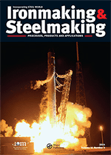
IRONMAKING & STEELMAKING
Pioneering Research in Metallurgical EngineeringIRONMAKING & STEELMAKING is a premier peer-reviewed journal published by SAGE Publications Inc, dedicated to advancing the field of metallurgical engineering and materials science. With a notable ISSN of 0301-9233 and an E-ISSN of 1743-2812, this journal has established itself as a significant platform for disseminating high-quality research on ironmaking processes, steel production, and associated technologies. Covering a broad scope of topics, it is indexed in the top quartiles (Q2) in Materials Chemistry, Mechanical Engineering, Mechanics of Materials, and Metals and Alloys for 2023, underscoring its pivotal role in these disciplines. Since its inception in 1974 and continuing through 2024, IRONMAKING & STEELMAKING attracts a global audience of researchers, professionals, and students, contributing valuable insights and innovations in the field. Although not an open-access publication, subscribers can access essential findings that shape the future of metallurgy and steelmaking. This journal not only serves as a repository of knowledge but also as a beacon for ongoing research and technological advancement, making it a must-read for those passionate about materials science.

CIS Iron and Steel Review
Unveiling Trends in the Iron and Steel IndustryCIS Iron and Steel Review is a prestigious academic journal published by ORE & METALS PUBLISHERS, specializing in the fields of Industrial and Manufacturing Engineering and Metals and Alloys. With a strong commitment to advancing knowledge in these critical areas, the journal has achieved a significant position, evidenced by its Q2 category rankings in both fields for 2023 and an impressive Scopus ranking alongside a substantial global readership. Operating from the heart of the Russian Federation, it provides a platform for researchers, professionals, and students to share innovative breakthroughs, explore trends, and discuss challenges within the iron and steel industry. The journal supports open access formats, enabling wider accessibility and dissemination of research findings, thereby fostering collaboration and engagement within the scientific community. With its converged years spanning from 2014 to 2024, the CIS Iron and Steel Review remains pivotal in enhancing the understanding of materials science and engineering practices in an ever-evolving industrial landscape.
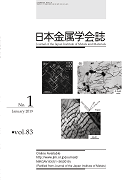
Journal of the Japan Institute of Metals and Materials
Advancing metallurgy and materials science since 1937.Journal of the Japan Institute of Metals and Materials (ISSN: 0021-4876, E-ISSN: 1880-6880) serves as a vital academic platform under the esteemed auspices of the Japan Institute of Metals & Materials. This journal, with a rich publication history dating back to 1937, focuses on advancing knowledge in the fields of metallurgy, materials science, and engineering, making it an important resource for researchers, professionals, and students alike. Although the journal has been categorized in Q4 quartiles across several subject areas, including Condensed Matter Physics and Materials Chemistry, it plays a critical role in disseminating essential findings and fostering discussion regarding innovations in metal and materials research. Notably, the journal operates without open access, which encourages targeted readership engagement through its curated content. Based in Japan, it continues to contribute significantly to the academic community by bridging the gap between scientific inquiry and practical application in materials technology.
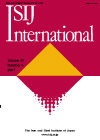
ISIJ INTERNATIONAL
Exploring the Frontiers of Materials Chemistry and EngineeringISIJ INTERNATIONAL is a distinguished open-access journal in the fields of Materials Chemistry, Mechanical Engineering, Mechanics of Materials, and Metals and Alloys, published by the esteemed IRON STEEL INST JAPAN KEIDANREN KAIKAN. Since its inception in 1986, ISIJ INTERNATIONAL has played a pivotal role in disseminating advanced research and critical findings in steel and iron industries, significantly contributing to innovations in materials science and engineering. With a commendable impact factor and categorized in Q2 quartiles across its relevant fields in 2023, the journal ranks favorably among other prestigious publications, evidencing its influence and relevance within the academic community. The journal promotes open access, allowing unrestricted online access to its published work since 2012, thus ensuring that researchers, professionals, and students can readily access cutting-edge research. The journal's comprehensive scope empowers researchers to connect over pioneering studies and methodologies that address contemporary challenges in materials and engineering domains, thereby fostering a rich dialogue and knowledge exchange.

TRANSACTIONS OF THE INDIAN INSTITUTE OF METALS
Unveiling new horizons in metal science.TRANSACTIONS OF THE INDIAN INSTITUTE OF METALS is a premier journal published by Springer India, dedicated to the field of metallurgy and materials science. Established in 1969, this journal serves as a vital platform for researchers and professionals to disseminate their findings on metals and alloys, showcasing innovative studies and experimental techniques. With an impressive impact factor and categorized in the Q2 quartile for metals and alloys as of 2023, it ranks 70 out of 176 in its field according to Scopus, placing it in the 60th percentile. The journal maintains a robust reputation for fostering academic excellence, thus attracting contributions from both established and emerging scholars. Though not an open access publication, its well-curated content remains a crucial resource for advancing knowledge and technology in metallurgy. The journal's extensive operational history, particularly during notable converged years, underscores its enduring significance in the scientific community.
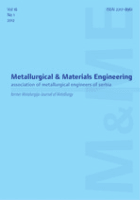
Metallurgical & Materials Engineering
Connecting researchers to the world of materials science.Metallurgical & Materials Engineering, published by Netherlands Press, is a prominent open access journal that has been advancing the field of metallurgical sciences and materials engineering since 2012. With an ISSN of 2217-8961 and an E-ISSN of 2812-9105, this journal provides a vital platform for researchers, professionals, and students to disseminate and access high-quality peer-reviewed research. As of 2023, it holds a Q4 quartile ranking in Mechanical Engineering and a Q3 ranking in Metals and Alloys, according to Scopus. This reflects its ongoing commitment to high standards despite being in a competitive sector. The journal covers a wide array of topics within the scope of materials science, with a focus on metallurgy and alloy technologies, and serves as a crucial resource for those engaged in innovative material development and application. Offering an open-access model emphasizes its dedication to making research widely available, thereby fostering collaboration and advancement in the materials engineering community. Join us in contributing to a dynamic and essential field of study.
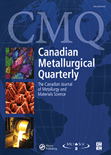
CANADIAN METALLURGICAL QUARTERLY
Championing Excellence in Metallurgical Research.Canadian Metallurgical Quarterly is a prestigious scholarly journal published by Taylor & Francis Ltd, dedicated to the field of metallurgical engineering and materials science. With a rich history dating back to its inception in 1962 and continuing through its most recent publications, this journal serves as a vital platform for the dissemination of innovative research, advancements, and critical reviews in metallurgy, metals, and alloys. Positioned strategically within the academic community, it holds a significant impact factor and is currently rated in the Q2 category for Metals and Alloys, and Q3 in Industrial and Manufacturing Engineering as of 2023, showcasing its authoritative role in these disciplines. Although it does not offer open access, the journal remains widely recognized for its rigorous peer-review process, ensuring that published work adheres to the highest standards of scientific quality. Researchers, professionals, and students alike will find invaluable insights and contributions that drive the field forward.

International Journal of Minerals Metallurgy and Materials
Connecting Scholars to the Heart of Materials ScienceThe International Journal of Minerals Metallurgy and Materials, published by SPRINGER, stands as a prominent forum in the fields of minerals, metallurgy, and materials science. With an ISSN of 1674-4799 and an E-ISSN of 1869-103X, this journal has been disseminating high-quality research since its inception in 2009 and will continue to publish until 2024. Based in China, this journal supports Open Access options, maximizing the reach and impact of scholarly work. Enhanced by its impressive Scopus rankings, it holds a Q2 position in Geochemistry and Petrology and a Q1 ranking in Materials Chemistry, Mechanical Engineering, Mechanics of Materials, and Metals and Alloys for 2023. Such accolades reflect its continual commitment to advancing knowledge in these disciplines, making it essential reading for researchers, professionals, and students aiming to stay abreast of contemporary developments and innovative solutions in materials science.

Latin American Journal of Solids and Structures
Advancing Solid Mechanics and Structural EngineeringLatin American Journal of Solids and Structures is a premier, open-access academic journal dedicated to advancing the field of solid mechanics and structural engineering. Established in 2003 and published by LATIN AMER J SOLIDS STRUCTURES, this journal provides a vital platform for innovative research and scholarly discourse, with a particular focus on applications within aerospace, automotive, civil, and mechanical engineering as well as ocean and materials science. Recognized for its rigorous peer-review process, it has proudly earned a Q2 ranking in Automotive Engineering and maintains a presence in several Q3 categories, highlighting its impact and relevance in a wide array of engineering disciplines. With a commitment to accessibility and knowledge dissemination, the journal encourages contributions from researchers, professionals, and students alike, fostering collaboration and advancement in the rapidly evolving field of structural engineering and materials science. Located in São Paulo, Brazil, it serves as a bridge between Latin American scholars and the global research community.
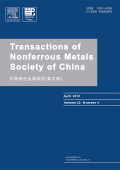
TRANSACTIONS OF NONFERROUS METALS SOCIETY OF CHINA
Elevating the discourse on materials chemistry and engineering geology.TRANSACTIONS OF NONFERROUS METALS SOCIETY OF CHINA, published by Elsevier, is a premier academic journal that serves as a vital platform for researchers and professionals specializing in materials science, condensed matter physics, geotechnical engineering, and engineering geology. Established in 1994, this esteemed publication has maintained a robust focus on the latest developments in the nonferrous metals sector, reflecting its significant impact in the field with a Q1 categorization across multiple disciplines. With impressive Scopus rankings—placing it in the top 20% of journals in relevant categories—this journal is recognized for its quality and rigor, providing critical insights into metals and alloys, materials chemistry, and their applications. The non-open access format ensures a dedicated readership among professionals and academics seeking substantial and authoritative research articles. By fostering knowledge exchange, the journal strives to advance the understanding and application of nonferrous metals, making it an essential resource for anyone involved in material innovations and engineering solutions.